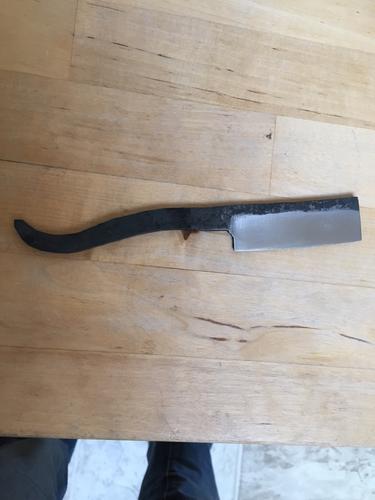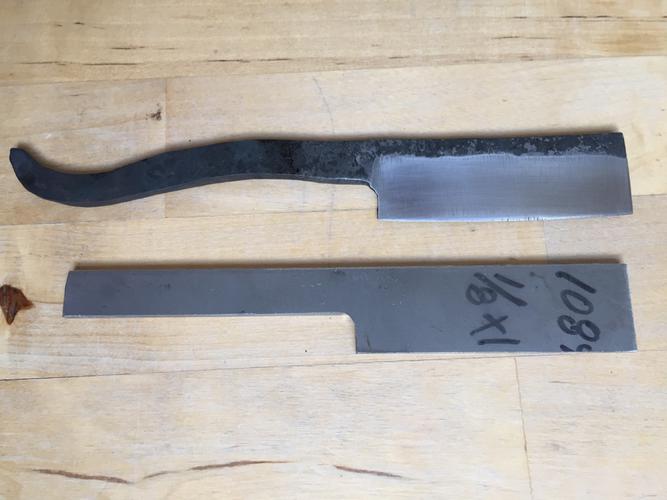Results 31 to 40 of 43
Thread: Forge insulation question
-
08-10-2015, 04:32 PM #31
-
08-10-2015, 04:55 PM #32

So the balance is between containing the heat/controlling combustion and allowing enough egress so you don't make a 'pop'?
-
08-10-2015, 05:58 PM #33"My words are of iron..."


- Join Date
- Oct 2006
- Posts
- 1,898
Thanked: 995
Yes, balance. You want to keep enough heat in a controlled place to heat the work so you can manipulate it. Fire wandering all over the place isn't useful. Focusing the energy of the fire can be enough, think torch tip, to burn right through a bar. Widen it out a bit and you can heat a whole piece of steel evenly. Having some of the heat squirt out the back hole in a forge is lost heat.
Plus, these venturi style burners do run a bit better with some back pressure. None of the burners I've build have flared tips. I do not need them to hold a standing flame on the end. The back pressure of the forge, e.g., a restriction at the mouth of the fire, holds the flame long enough for the forge walls to heat to above the auto-ignition temperature of the air-gas mix and then it becomes self sustaining. Closing down the lost heat contains more heat inside where I put the steel instead of lost to the atmosphere. You only need a thin little opening to get some tongs and a razor inside anyway.
If you're going to be working on a bigger piece then use the bigger hole, put your steel inside, then close it down again until the steel heats up. Forge doors or firebrick are cheap additions to controlling the heat.
-
The Following User Says Thank You to Mike Blue For This Useful Post:
Atchbo (08-24-2015)
-
08-10-2015, 06:07 PM #34"My words are of iron..."


- Join Date
- Oct 2006
- Posts
- 1,898
Thanked: 995
Never had a pop on a running forge that worried me. I've had electrically blown forges where the blowers quit and that makes for a largish fire ball that quickly collapses. Pure LP won't burn very well. It needs oxygen. When there's not enough air the fire dies down. The flame moves upward toward the ceiling and is a great reason to put your gas shut off's down near the floor or away from the fire on a wall somewhere removed...
A venturi entrains its own air so there is nothing to fail and it can't over-deliver either fuel or air making for a relatively safer system. You don't have to worry about electrics going out. If the forge burner fell to the floor, the ignition system is inside the hot lining of the fire, unless you have other sources of flame handy nearby you should have time to shut off the gas. Even so, the burners I use don't hold a standing flame so they won't light anything on fire like a loose torch would.
There are those who could say I'm more confident than I should be. That's okay too.
Now a leaking LP line into a tightly closed room and just the right mix of air and gas could make for a different experience.
-
The Following User Says Thank You to Mike Blue For This Useful Post:
Atchbo (08-24-2015)
-
08-10-2015, 07:04 PM #35

Why don't your burners hold a standing flame? Do they huff?
-
08-22-2015, 10:45 PM #36

Forge is working great! The internal volume was too large so I added another layer of insulation and Titebond mortar. Works like it should!
I also added a front sliding door (fire brick sliding in angle iron channel.
I also tried adding a hard fire brick inside and it worked eventually but took forever to heat up. I liked it when it was hot though.
-
08-22-2015, 10:47 PM #37

I always had blue flame coming out. While inside was orange and glowing. Good day in the shed.
-
08-22-2015, 11:08 PM #38
-
The Following User Says Thank You to Atchbo For This Useful Post:
spazola (08-23-2015)
-
08-23-2015, 06:18 PM #39"My words are of iron..."


- Join Date
- Oct 2006
- Posts
- 1,898
Thanked: 995
No, once the lining has come up to autoignition temperature it's a nice steady fire. I did not add a flare to the burners since the tip is working inside the forge wall and the flare is built/formed into the refractory. Still, it's more back pressure, swirl/gas-air mix, and forge volume that keeps the flame working.
Sounds good. Yes, the hard brick refractories do take more time to warm up, but they also stay hot longer too. It helps moderate the temperature loss when you throw some cold steel in there to warm up.
-
The Following User Says Thank You to Mike Blue For This Useful Post:
Atchbo (08-24-2015)
-
08-24-2015, 03:45 AM #40

Thanks, Charlie. I love your work and major thanks for all of your videos.
It's cool to have such great craftsmen here on this forum.


 33Likes
33Likes LinkBack URL
LinkBack URL About LinkBacks
About LinkBacks







 Reply With Quote
Reply With Quote

